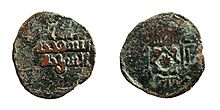Abdallah of Cordoba
ʿAbdallāh ibn Muhammad ( Arabic عبد الله بن محمد, DMG ʿAbd Allāh ibn Muḥammad , Spanish Abdalá I , born January 11, 844 ; † October 15, 912 ) was the seventh emir of Córdoba (888–912).
Life
ʿAbdallāh, whose reign was described in detail by the chronicler Ibn Hayyān, took control of the emirate in June 888 after the sudden death of his brother al-Mundhir , who had been involved in battles with ʿUmar ibn Hafsūn before Bobastro . He himself was accused of having poisoned his brother in order to be able to take over rule in al-Andalus.
The uprisings and revolts against the Umayyads initially expanded under his rule. Murcia and Valencia were lost in 889 , and other members of the Umayyad clan set up their own business in Ronda and Seville . In addition, due to the chaos of war, a severe economic crisis broke out in Andalusia . In this situation he had to officially recognize ʿUmar ibn Hafsūn as governor in Granada . In 891 there was a revolt by his own son Muhammad. ʿAbdallāh put down the various uprisings with a cruel hand and executed several Umayyads whom he saw as a threat, including his two sons Muhammad (891) and Mutarrif (895). The execution of Mutarrif, who was involved in the execution of his brother, was justified on charges of heresy ( zandaqa ).
At times, Abdallah only controlled the area around Córdoba . The height of the crisis was reached when Abdallah took over the sovereignty of Alfons III around 900. from Asturias across Spain . However, Alfons III. of Asturias a campaign against Umar ibn Hafsun, which he inflicted several heavy defeats. This led to resistance from the Muslim clergy, who accused Abdallah of being a vassal of a Christian king.
But Abdallah increasingly succeeded in playing the rebels in the individual provinces off against one another and in strengthening his position. When he was able to ally himself with the Banu Khaldun, Umar ibn Hafsun was largely isolated in the south.
After the death of Abdallah (912), his grandson was Abd ar-Rahman III. Emir of Córdoba and led the empire out of crisis and to a new high point.
literature
- Isabel Fierro Bello: La Heterodoxia en Al-Andalus durante el periodo Omeya . Instituto Hispano-Arabe de Cultura, Madrid, 1987. pp. 97-124.
- Wilhelm Hoenerbach : Islamic history of Spain. Translation of the Aʿmāl al-Aʿlām and additional texts. Artemis, Zurich / Stuttgart, 1970. pp. 101-106.
- Evariste Lévi-Provençal: Histoire de l'Espagne musulmane . Paris 1999 (repr.). Vol. I, pp. 329-96.
- Luis Molina: “ʿAbdallāh b. Muḥammad b. “Abd al-Raḥmān.” In: Encyclopaedia of Islam, THREE. Brill Online 2015.
Individual evidence
- ↑ See Évariste Lévi-Provençal : Du nouveau sur le royaume de Pampelune au IX e siècle , in: Bulletin Hispanique 55, 1953, pp. 18 and 21.
- ↑ Cf. Fierro Bello: La Heterodoxia en Al-Andalus . 1987, p. 97.
- ↑ Cf. Molina: ʿAbdallāh b. Muḥammad b. ʿAbd al-Raḥmān . 2015.
- ↑ Cf. Fierro Bello: La Heterodoxia en Al-Andalus . 1987, pp. 101-106.
| predecessor | Office | successor |
|---|---|---|
| Al-Mundhir |
Emir of Cordoba 888–912 |
Abd ar-Rahman III. |
| personal data | |
|---|---|
| SURNAME | Abdallah of Cordoba |
| ALTERNATIVE NAMES | Abdallah; عبد الله بن محمد (Arabic); ʿAbd Allaah ibn Muḥammad; Abdalá I (Spanish) |
| BRIEF DESCRIPTION | Emir of Cordoba |
| DATE OF BIRTH | January 11, 844 |
| DATE OF DEATH | October 15, 912 |
